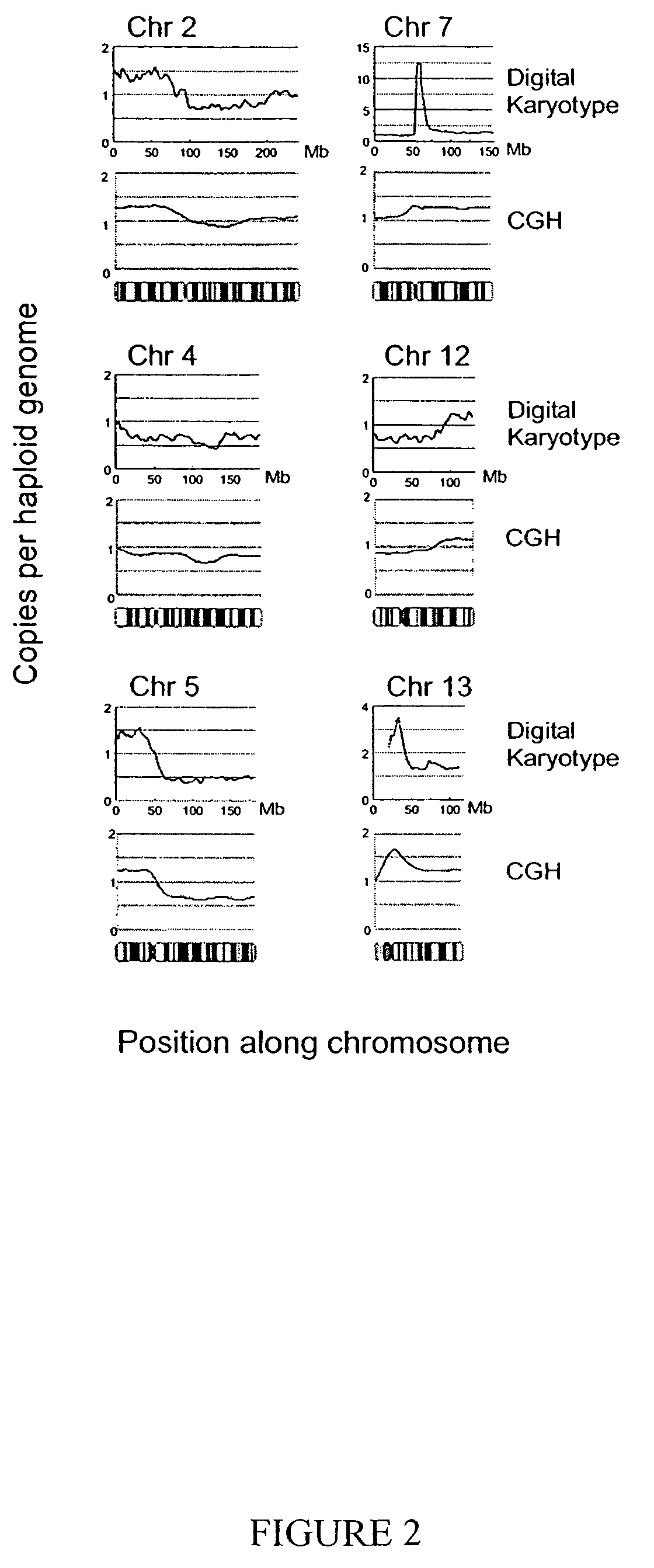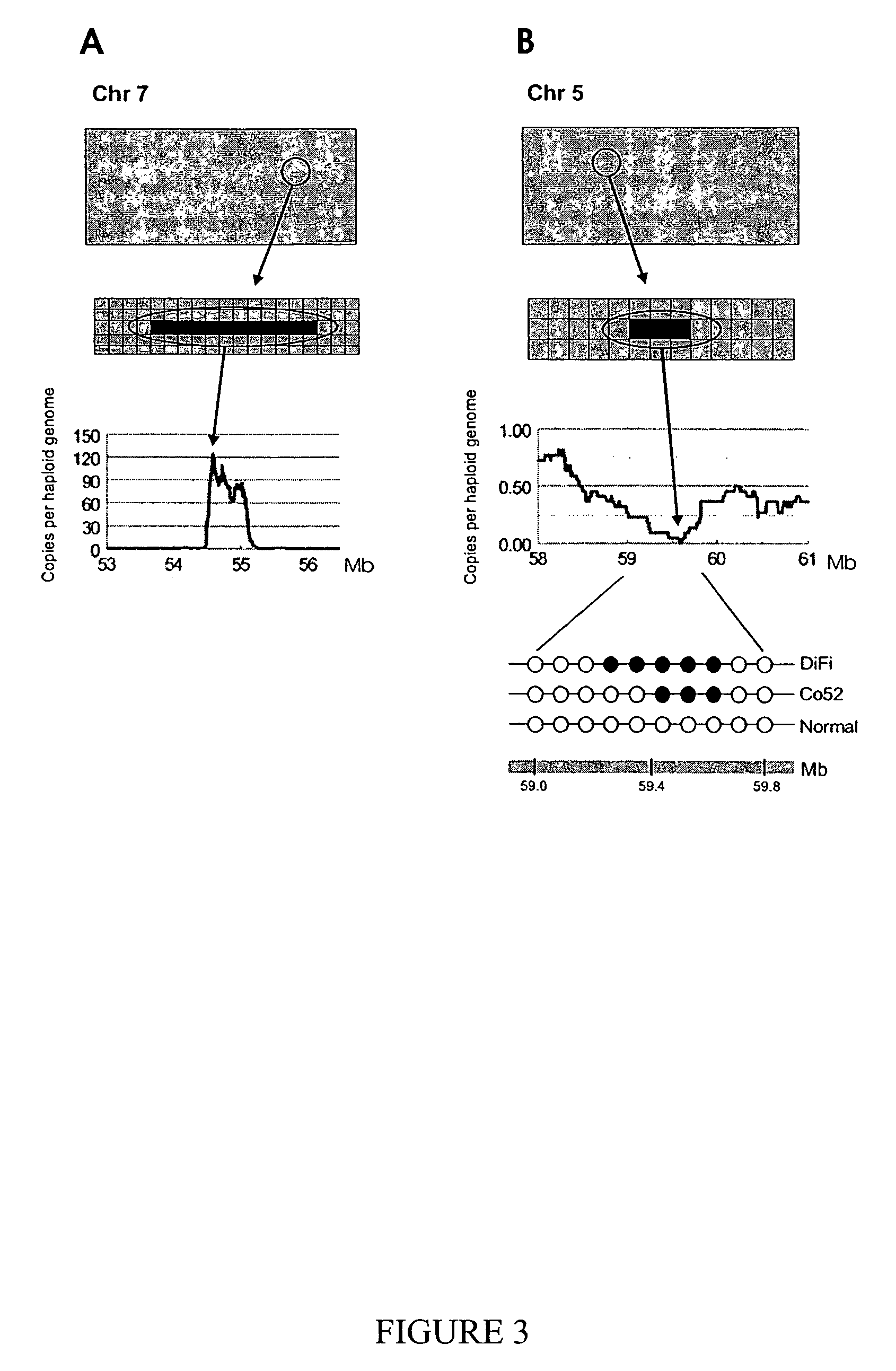Digital karyotyping
a digital karyotype and genome technology, applied in the field of genetics, can solve the problems of limited sequence number, inability to detect small alterations, and hidden abnormalities at the cellular and organismal level
- Summary
- Abstract
- Description
- Claims
- Application Information
AI Technical Summary
Benefits of technology
Problems solved by technology
Method used
Image
Examples
example 1
Principles of Digital Karyotyping
[0025]These concepts are practically incorporated into Digital Karyotyping of human DNA as described in FIG. 1. Genomic DNA is cleaved with a restriction endonuclease (mapping enzyme) that is predicted to cleave genomic DNA into several hundred thousand pieces, each on average 6 / 44), the majority of DNA molecules in the template are expected to be cleaved by both enzymes and thereby be available for subsequent steps. DNA fragments containing biotinylated linkers are separated from the remaining fragments using streptavidin-coated magnetic beads (Step 3). New linkers, containing a 5-bp site recognized by MmeI, a type IIS restriction endonuclease (18), are ligated to the captured DNA (Step 4). The captured fragments are cleaved by MmeI, releasing 21 bp tags (Step 5). Each tag is thus derived from the sequence adjacent to the fragmenting enzyme site that is closest to the nearest mapping enzyme site. Isolated tags are self-ligated to form ditags, PCR am...
example 2
Analysis of Whole Chromosomes
[0028]We characterized 210,245 genomic tags from lymphoblastoid cells of a normal individual (NLB) and 171,795 genomic tags from the colorectal cancer cell line (DiFi) using the mapping and fragmenting enzymes described above. After filtering to remove tags that were within repeated sequences or were not present in the human genome (see Materials and Methods), we recovered a total of 111,245 and 107,515 filtered tags from the NLB and DiFi libraries, respectively. Tags were ordered along each chromosome, and average chromosomal tag densities, defined as the number of detected tags divided by the number of virtual tags present in a given chromosome, were evaluated (Table 2). Analysis of the NLB data showed that the average tag densities for each autosomal chromosome was similar, ˜0.16+ / −0.04. The small variations in tag densities were likely due to incomplete filtering of tags matching repeated sequences that were not currently represented in the genome da...
example 3
Analysis of Chromosomal Arms
[0030]We next evaluated the ability of Digital Karyotyping to detect subchromosomal changes, particularly gains and losses of chromosomal arms. Tag densities were analyzed along each chromosome using sliding windows containing 1000 virtual tags (˜4 Mb), as windows of this size were predicted to reliably detect such alterations (Table 1). For the NLB sample, tag density maps showed uniform content along each chromosome, with small variations (<1.5 fold) present over localized regions, presumably due to overrepresentation of tags matching repeated sequences (data not shown). In contrast, the DiFi tag density map (normalized to the NLB data) revealed widespread changes, including apparent losses in large regions of 5q, 8p and 10q, and gains of 2p, 7q, 9p, 12q, 13q, and 19q (FIG. 2 and FIG. 5). These changes included regions of known tumor suppressor genes (21) and other areas commonly altered in colorectal cancer (11, 12, 22). These alterations were confirme...
PUM
| Property | Measurement | Unit |
|---|---|---|
| size | aaaaa | aaaaa |
| densities | aaaaa | aaaaa |
| density | aaaaa | aaaaa |
Abstract
Description
Claims
Application Information
 Login to View More
Login to View More - R&D
- Intellectual Property
- Life Sciences
- Materials
- Tech Scout
- Unparalleled Data Quality
- Higher Quality Content
- 60% Fewer Hallucinations
Browse by: Latest US Patents, China's latest patents, Technical Efficacy Thesaurus, Application Domain, Technology Topic, Popular Technical Reports.
© 2025 PatSnap. All rights reserved.Legal|Privacy policy|Modern Slavery Act Transparency Statement|Sitemap|About US| Contact US: help@patsnap.com



